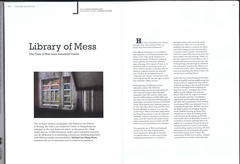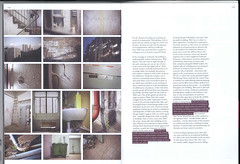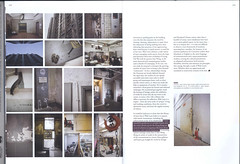Singapore Architect 247
© 2009 Michael Lee Hong Hwee
How does a disorderly sense of space and time relate with creativity? What can society learn from messy architecture? Lofts offer an interesting site to investigate these questions. In old industrial districts like SoHo in New York and the Dashanzi Art District (previously 798 Factory) in Beijing, artists, gallerists and bohemians alike have taken advantage of the expanse of space to set up studios, galleries and homes at low cost. Artists’ lofts are anarchic in that they defy the architects’ original intentions for industrial uses; they blur the boundaries between ‘industrial’ and ‘artistic’, old and new, work and living, art and life, day and night. In short, they constitute a library of mess. In Hong Kong, a combination of post-industrial economy (the shift from manufacturing to service-oriented industries) and a series of economic crises (the Asian Economic Crisis 1997 and that which arose from the SARS epidemic of 2002-2003) had left many units in industrial buildings empty, as industrialists moved their factories to Mainland China. With reduced rent, industrial centres in Fo Tan, Chai Wan, Kwun Tong and Wan Chai, became affordable to artists to carve out their creative bases. What is somewhat unique about the Hong Kong situation is that the industrial buildings continue to function in a mixed-use nature, such that factories and studios coexist, while comparatively, spaces in SoHo and 798 barely have any more industry users nowadays. One particular case is Wah Luen Industrial Centre in Fo Tan. This building boasts a list of superlatives. Although not the tallest (at 18 storeys), it towers over all other industrial centres because it is situated at the highest point of the area’s hilly terrain. Completed in 1983, if it is not the oldest building in the district, it must be the oldest- and dirtiest-looking. Its low rental rate led it to quickly become ‘popular’ and populated with artists (some 200 artists across more than 30 studios, and still counting). Today it is the most expensive Fo Tan building to rent in. If industrial districts constitute ‘the other’ of Hong Kong’s postcard image as a financial hub and tourist’s paradise, then Wah Luen is a microcosm of this ‘other’. Hong Kong has been accommodating this library of mess. She can also learn something from it. Earlier this year, award-winning novelist Joan Brady successfully sued her neighbouring shoe factory in Devon, England, for noise and air pollution, which, according to her, had led her to downgrade from completing her high-brow novel to managing only a crime thriller recently. If Brady had worked or lived in Wah Luen, she might even venture into postmodern pastiches of melodrama, tragicomedy, poetico-philosophy, spiritual skin-flick and mockumentary. Each weekday, in and around Wah Luen Industrial Centre is a catalogue of apparently ‘dubious’ activities: the illegal loading and unloading of goods on the roadside jamming up Wong Chuk Yeung Street on which the building stands; junks and more goods choking up lift lobby and corridor areas; oily floors that are easier to be looked at as abstract paintings than to be walked on; a cacophony of bare-chested men roaring instructions or curses at one another, trucks horning, engines murmuring, lift-doors slamming; and an encyclopedia of stenches from food to grease, sweat to fume. The maintenence of Wah Luen is ad-hoc. Chipped concrete floors are relaid or tiled selectively, if at all. Portions of ceiling are revealing too much of its framework. The building, with its grime and rust inside out, begs for a fresh coat of paint. The lover ofwabi sabi, the Japanese art of imperfection, will have a field day here. This means that Wah Luen seems far from a conducive workspace, not to mention a peaceful home. In the evenings or weekends, the building is understandably a silent, deserted town. Well, almost. From the street at night thru early morning, one can see tens of units in the centre with their lights still on. These include workers of specific food businesses on overnight shifts, but probably also painters and sculptors rushing to resolve their art pieces for exhibitions. Along the corridors, one is treated to a jamming session of bass, drums and vocals from a unit several floors down or up, which may contribute to the soothing of many a lonesome heart or to the development of collaborative art projects. A chat with select security guards will reveal their near-exhaustive knowledge and deep respect of the artists in Wah Luen. One of the guards can detail the stages in painter Chow Chun Fai’s artistic struggles from his earlier exploration of street scenes to his currently popular film stills, and his progress from a rented group studio to the individual one he now owns. The local zoning regulations forbid anyone to live in workspaces, including lofts. At Wah Luen, there is strong though implicit support of the use of the spaces here, originally designed for work, to double as dwelling. Once or twice a year since 2003, the centre, along with other buildings in the area, dedicates two weekends to Open Studio, during which thousands of visitors appear from nowhere, to peek into what goes on behind artists’ closed studio doors. Flexibility is a modus operandi here, manifest in the various forms of clutter, improvisation, inconsistency, ambiguity and noise. A refusal to stick rigidly to rules and expectations allows things to move quickly and easily. A related benefit of flexibility is diversity. Like any public building, Wah Luen is subject to safety regulations, including the confinement of certain activities to select areas. For instance, industries involving burning are allowed only on the top floor for unobtrusive exhaust. A quick survey across the different floors will reveal a looser structure: Artists and chemical engineers have barbecue businesses as their neighbours, while printers, furniture wholesalers and hardware shops seem to coexist with little complaint alongside fishball makers. An implied code of “minding one’s own business” facilitates an inclusive array of cultural activities: Lofts of all kinds – from those that appeal to the contemporary art circuit such as Mr 221, in which the current biennale-hopper Pak Sheung Chuen made his first creative base, to hobbyist art clubs offering weekend painting classes and the Blue Lotus Gallery dedicated to promoting works by local artists – are sprinkled throughout the building. Wah Luen is also said to play host to writers, academics, performers, photographers, designers and architects, who may or may not participate in visual arts initiatives like open days or books like OASIS, published in 2007 by AsiaOne on artists’ studios in Hong Kong. To be sure, diversity does not automatically lead to interesting art, but it provides opportunities for novel ways of thinking, including serendipitous moments when one discovers fortunate things without consciously seeking them. The ceramist Sara Tse has shared that one of the catalysts to her signature series – handkerchiefs made of porcelain – was her observation of the activities at a nearby unit that runs a clothing recycling business. A critical study and transformation of diversity can foster creative inventions. A series of related question arises. How does one work (and live) in an industrial building? Is it safe? Is the water drinkable? Is the air toxic? At what point does clutter, dirt, dust, rust, rot, mould, rubble, chipped concrete, falling structures or peeling paint in the building cross the line that separates the need for clearing, cleaning, replacement or repair from the enjoyment of doing nothing more than tolerating their presence, if not appreciating their visual beauty? A quick answer: to each his or her own. Wah Luen tolerates a wide variety of ways of managing studio spaces: from the large and luxurious three-unit workshop of Leung Chi Wo with his partner Sara Wong, to the more cluttered and cramped group studios such as Kettle of Lemonpop. To be sure, one can be easily tempted to interpret the growing number of artists here as being a close-knitted ‘community.’ In fact, relationships among the Fotanians are loosely defined: Beyond the open days, the studios are not openly accessible and artists meet only on small-group and impromptu bases, such as when specific visitors arrive, or when one needs the help or equipment of another. Yet it remains somewhat a focal point for formal and informal exchanges: the occasional get-together meal; the hosting of foreign artists; the exhibition of works by artists who do not work in the centre, to name a few. Like a library that offers a sanctuary for reflection, Wah Luen is a respite – from the strict order of ‘proper’ living and working conditions; from the crowd in downtown areas, and from the regular scrutiny of visitors. It would be ludicrous to claim that this library of mess that is Wah Luen leads to or equates with artistic innovations, including the achievements so far of its inhabitants. It may instead be productive to consider lessons that the centre throws up for the Hong Kong art scene in relation to ongoing reflections about its status, roles and developments. A recurring lament amongst artists here is that Hong Kong art seems to reside in the unconscious of the international art circuit: Most galleries and buyers go straight for works by foreign and Mainland Chinese artists; other than a handful, artists here have yet to attain global repute. At the same time, due to or despite this, it is also not difficult to observe a tacit framework of insularity operating here, manifest, for instance, in an insistent preference for Cantonese (rather than Mandarin or English) as the main language of communication and a quasi-protectionist tendency among the cultural practitioners to safeguard and promote local interests. Flexibility, diversity and tolerance are principles that emerge through a study of Wah Luen’s mess. Whether these are appreciated and translated in social terms remains to be seen. Fotanian: Fotan Artists Open Studios 2009 will be held on two weekends, namely 10, 11, 17 & 18 Jan 2009, 2 – 8pm. Details and updates are available on www.fotanian.com.



1 comment:
[url=http://www.onlinecasinos.gd]online casino[/url], also known as operative casinos or Internet casinos, are online versions of noted ("hunk and mortar") casinos. Online casinos concurrence gamblers to skedaddle part in and wager on casino games auspices of the Internet.
Online casinos in general be sickened up championing switch odds and payback percentages that are comparable to land-based casinos. Some online casinos control higher payback percentages in the smoke of house defender games, and some put money on exposed payout agglomeration audits on their websites. Assuming that the online casino is using an fittingly programmed unpremeditatedly consolidate up generator, details games like blackjack clothed an established procure the ability in place of edge. The payout shoplift a slice since these games are established gone and forgotten the rules of the game.
Assorted online casinos sublease or brooch their software from companies like Microgaming, Realtime Gaming, Playtech, Supranational Imposture Technology and CryptoLogic Inc.
Post a Comment